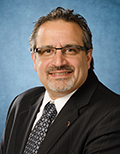Page Content
Mapping Crossroads
 When I’m questioned about why I am so interested in civic responsibility and social justice, my answer is straightforward: I had the best teacher! He was a man who profoundly influenced me and, in part, made me the man I am today. This man was a master teacher, a champion of the human spirit, a United Nations Global Citizen, a recipient of the Order of Canada and a visionary.
When I’m questioned about why I am so interested in civic responsibility and social justice, my answer is straightforward: I had the best teacher! He was a man who profoundly influenced me and, in part, made me the man I am today. This man was a master teacher, a champion of the human spirit, a United Nations Global Citizen, a recipient of the Order of Canada and a visionary.
His name was Steve Ramsankar, and he was my father.
Many programs in schools today exist because of my father, who was principal of Alex Taylor School, in Edmonton’s inner city. Assessing the needs of children in the school when he first started teaching led him to create what he called a “holistic approach” to working with children. In other words, if a child’s basic needs are met, that child can begin working towards his or her full potential. When my father first began teaching in the 1970s, he focused on students’ five essential needs: physical, emotional, spiritual, social and intellectual.
Meeting basic needs
We’ve all witnessed the terrible effects of child poverty. Children who arrive in our classrooms cold and hungry make us feel angry and helpless. My dad witnessed this first-hand. He often said that a hungry child couldn’t focus on learning. Arriving at school in dirty clothes or clothes unsuited to cold weather also interferes with learning. His goal was simple: meet students’ basic needs, and physical discomforts will decrease and their level of comfort will increase, allowing them to become engaged in classroom activity. Clothing and feeding the children who attended Alex Taylor School became his priority, so he organized a mid-morning nutritional snack and hot-lunch program.
Giving hugs
When I was growing up, I saw my dad greet students and community members with a hug. No wonder it’s normal for me to hug someone when I’m saying hello or goodbye. A sense of security is an important basic need for a child who arrives at school afraid of his or her environment. My father believed that if a child felt secure at school, then he or she would take risks required for learning. Many children today are refugees from countries where a fear of authority and the police are commonplace. Greeting families warmly encourages them to ask questions about the school and education. It encourages them to be active school-community members who engage teachers in the school and became part of the school’s wider family.
Providing safety and security
Sometimes, providing children with a sense of security requires the presence of police. In Canada, the police serve and protect us. This isn’t the case for children who come from countries where police are corrupt and feared. Dad believed that the children in his care needed to view the police as a valuable resource. He introduced students to police at a young age in the hope that it would ease the tensions that students experienced at school. Today, police work with schools in communities all across Alberta to support the work of teachers and administrators.
Celebrating multiculturalism
Steve Ramsankar was made an honorary chief of the Cree Nation. His name was Chief Big Heart. Dad saw the multicultural mix in his school and acknowledged the importance of each community’s customs and celebrations. Everyone was welcome. Worship services were accommodated in the school. Chinese New Year was celebrated every year, and Aboriginal culture was taught. Cree children learned Cree. Meeting students’ and the community’s emotional and social needs was modelled, not just talked about. My dad said that policy was one thing but action is what people will recognize as true caring. I believe this and seek action in the work I do representing students in my classes. In my school community, I was an administrator and now I represent Alberta’s teachers. Our actions are powerful statements of who we are and what we believe.
Crossing borders
The international programs that extend beyond our borders drive some of the teaching in today’s social studies curriculum and extracurricular school activities. Encouraging students to think beyond their communities and instilling in them a sense of global citizenship inspires many classroom and school projects. Such projects developed under the guidance of excellent teachers are found throughout Alberta. In many cases, teachers, staff and students go beyond the classroom experience to participate in humanitarian efforts and development projects. This is connecting globally.
The Alberta Teachers’ Association supports educational projects beyond provincial and federal borders, and the articles in this issue of the ATA Magazine capture this notion clearly. I believe that projects undertaken overseas by the ATA—activities that make us global citizens—are holistic in nature and that assisting people is a humanitarian act. However, as teachers do their part to shrink the globe and assist communities in other countries, we must not forget about our own communities—humanitarian efforts often start at home.
I am blessed to have had my father and my most influential teacher, Steve Ramsankar, model this approach to me during my formative years.
